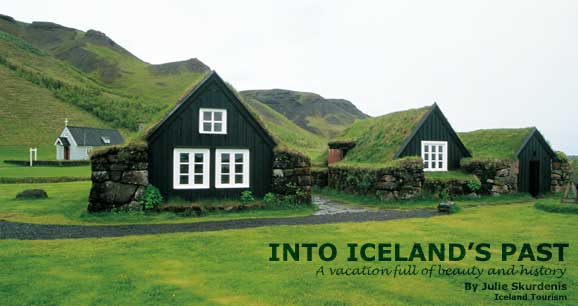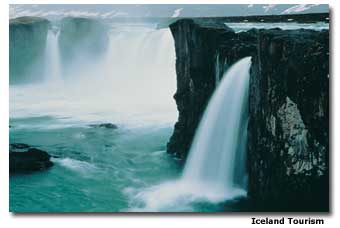
 I first made the acquaintance of Erik the Red in the fourth grade. I was intrigued by this 10th century Viking who left the country of his birth (Norway), settled in another (Iceland), then exiled and re-settled in yet a third country (Greenland). Of course, at nine years old and in a far gentler time, we were not told that Erik the Red was not the most savory of characters. He was actually expelled from Iceland for murder. And the adjective “red” following his name could equally have referred to the color of his hair and beard, or the blood on his hands.
I first made the acquaintance of Erik the Red in the fourth grade. I was intrigued by this 10th century Viking who left the country of his birth (Norway), settled in another (Iceland), then exiled and re-settled in yet a third country (Greenland). Of course, at nine years old and in a far gentler time, we were not told that Erik the Red was not the most savory of characters. He was actually expelled from Iceland for murder. And the adjective “red” following his name could equally have referred to the color of his hair and beard, or the blood on his hands.
I was fascinated by Erik, but surprised to learn that his son, Leif Erikson, may have been the first person to “discover” America in 1000 A.D. ― a good 492 years before Christopher Columbus, which I regarded as heresy at the time.
Iceland is perhaps one of the most beautiful countries on earth: a spectacular paradise of hot springs, glaciers, mountains, waterfalls, lakes and volcanoes. Its beautiful scenery is why most people venture to its shores. I too, came for the beauty, but I did not forget my childhood hero, Erik and his son Leif.
What is left of Erik’s home is located in the idyllic Haukadalur Valley in the western part of Iceland, about 120 miles (193 km) north of the capital city of Reykjavik. Archaeologists who excavated the site in the late 1990’s believe this is where Erik lived and where Leif was born.
The site sits high on a hillside overlooking the valley with a small waterfall close by. There is the foundation of a longhouse fairly typical of the Viking period with a rectangular area approximately 13 by 39 feet (4 by 12 m) divided into several sections serving different functions. Around a central hearth, there was an area for cooking, living and sleeping, with another smaller section to one side that served as a kitchen, and a third area on the opposite side for the storage of farm implements.

It would take a fairly vivid imagination to picture the house as it must have looked a thousand years ago, but fortunately a replica was constructed four years ago and stands only a few steps away from where the actual longhouse stood. The replica longhouse has a dirt floor, turf walls and turf roof. In the central area surrounding the hearth are beds for the entire family, as well as for the slaves. A ladder leads to a loft where the children of slaves slept.
Guides dressed as Vikings describe the troublesome personality of Erik the Red. They also give visitors an idea of what it was like to live in the 10th century, in what was then a newly settled and remote land. A Norwegian, Ingolfur Arnarson, first took up residence in Iceland in 874 A.D., merely a century before Erik the Red would have built his house in the Haukadalur Valley.
Outside the reconstructed longhouse stands a statue of Leif Erikson with a faraway look in his eye ― probably dreaming of new lands to discover. Leif eventually sailed to the North American continent, reaching Baffin Island, Labrador and a place he called Vinland, as yet unidentified.
Having finally visited the Icelandic home of Erik and Leif, it was on to Thingvellir ― the most important historical site in Iceland.
Located 26 miles (42 km) northeast of Reykjavik, it was here at Thingvellir in 930 A.D., that Iceland’s chieftains began meeting for two weeks each summer in an assembly or parliament called theAlthing.
At each year’s Althing, they settled disputes, traded and socialized. These annual assemblies lasted for 868 years, finally replaced in 1800 by the Parliament in Reykjavik.
Visitors come to Thingvellir more for the spirit of the place than for the sights, although there are remnants of budir, roofed camps once used as meeting places and places of business during the assemblies; pools where women accused of witchcraft were drowned (men were beheaded); and the supposed site of the Lögberg (Law Rock), where Iceland’s laws were recited aloud by a lawspeaker.
The site itself is physically striking. Visitors walk along a high cliff at the very edge of a great geological rift where the North American continental plate is gradually separating from the Eurasian plate. Far below sits the site of the Althing beside the Öxara River.

After leaving Thingvellir, there were two other archeological sites I wanted to visit. Although 300 years apart in time, these two sites are historically connected.
The first, located at Borgarnes, 40 miles (64 km) north of Reykjavik, is the 10th century burial mound of one of Iceland’s earliest settlers, Skallagrimur Kveldulfsson. In true Viking-style, his horse and his weapons are buried with him. Skallagrimur was the father of Egill Skallagrimsson, who is the hero of one of Iceland’s greatest folk tales, “Egill’s Saga.” Egill was a Viking adventurer who traveled to Norway and England and engaged in a continuing conflict with King Eric Bloodaxe of Norway.
This connected nicely with the second site at Reykholt, 20 miles (32 km) northeast of Borgarnes. Snorri Sturluson, one of Iceland’s most famous writers and historians, lived in Reykholt in the late 12th to early 13th centuries. Snorri, who counted Egill as one of his ancestors, is credited with writing Egill’s Saga. Snorri was murdered in 1241, on the orders of the Norwegian king, for reneging on a deal. The only thing left of what was once Snorri’s farm is a large circular pool fed by a hot spring, where Snorri must have relaxed many a time 800 years ago.
Besides its 1,100-year-long history, Iceland offers natural, mind-boggling beauty in abundance. In the words of my husband Paul, “My eyes are full.” We spent two weeks touring Iceland and visited at least 30 scenic spots. Here are some of my favorite “don’t miss” places.
The Blue Lagoon (yes, it really is blue) close to Reykjavik’s International Airport is guaranteed for a unique experience of soaking in a huge, warm “hot pot” in a setting of black lava. The Vatnajökull glacier located on the southeastern shore of the island approximately 280 miles (450 km) east of Reykjavik, is the largest in Europe, approximately 3200 square miles (8287 km²) ― roughly 160 miles (257 km) by 160 miles (257 km) ― where visitors can walk up to the edge of one of the many glacial arms. Gullfoss, located an hour and a half east of Reykjavik, and Godafoss, approximately 47 miles (75 km) east of Akureyri, northern Iceland’s largest city, are two of the most impressive waterfalls in a land full of waterfalls.
While in Northern Iceland, check out the placid, duck-filled expanse of Lake Myvatn, situated 57 miles (91 km) east of Akureyri. Visitors of the lake can observe the 18 species inhabiting the area, including harlequin, old squaw, scoter, and tiny, black, annoying flies. A gauze netting over the face will keep them at bay.
Just 50 miles (80 km) east of the lake is the surreal collection of twisted lava towers of Dimmuborgir. If venturing back south, Strokkergeyser, just east of Gulfoss, is a sight to see. It erupts every few minutes, spouting 90 feet (27 m) into the air. This is only a sampling of what Iceland has on tap.
And do not miss Iceland’s sophisticated capital Reykjavik, which is full of good restaurants and intimate cafés. A few of our favorite activities: strolling around the Old Town, examining the ancient saga manuscripts at the Culture House, and viewing the Erró exhibit at the Hafnarhusix Museum. Pop Artist Erró ( Gudmundur Gudmundsson) was born in 1932 and is one of Iceland’s best-known modern artists.
We also listened to an organ recital in the ultra modern Hallgrimskirkja church, visited the modern art exhibit in the National Gallery of Iceland, meandered among the superb sculptures in the garden of the Einar Jonsson Museum and stopped at each and every café along Laugavegur, Reykjavik’s main shopping street.
Reykjavik offers an intimate setting, a range of things to do, and a bustling atmosphere, plus all-around-you beauty spots just outside the city limits. Add a touch of history ― the ancient Parliament site or Erik the Red’s home ― and you’ve got the recipe for a great holiday.
If You Go
Icelandic Tourist Board
www.icetourist.is
Iceland Tourist Board North America
www.icelandtouristboard.com
- New Florida, Old Soul: Why Port St. Lucie Should Be Your Next Sunshine State Escape - July 1, 2025
- Samaná: The Dominican Republic’s Lush Peninsula Where Silence is Golden and So Is the Sand - July 1, 2025
- Europe’s 12 Most Interesting Museums: From Underground Salt Mines to Chocolate Fountains - July 1, 2025
